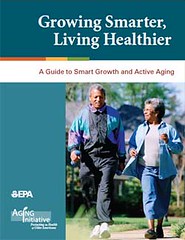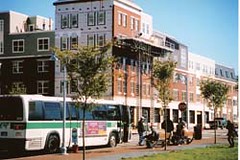Smart growth and active aging: EPA’s informative new guide

Posted August 21, 2009 at 1:32PM
A major challenge that has come with sprawl over the last half-century has been that growing up, maturing, and growing older has required, more often than not, moving to a new community at each new stage. This is largely because we have created subdivisions with only one type of housing, within one price range, and with few options for people who cannot or should not drive.
 For example, a neighborhood with only one type of housing that works for our family when we are kids may not be well-suited for us when we become young adults. Types of housing and amenities that suit us as young singles may not work as well if we choose to begin a family. Places that work for a family with toddlers might not work as well for teenagers. When we become empty nesters, we again have different needs, and yet again when driving becomes difficult and access to medical care more important.
For example, a neighborhood with only one type of housing that works for our family when we are kids may not be well-suited for us when we become young adults. Types of housing and amenities that suit us as young singles may not work as well if we choose to begin a family. Places that work for a family with toddlers might not work as well for teenagers. When we become empty nesters, we again have different needs, and yet again when driving becomes difficult and access to medical care more important.
While encountering new people and situations in new neighborhoods along the stages of life can be enriching, it also can be expensive and inconvenient. And, for communities, it means that people in different situations are seldom part of the same neighborhoods for long, deprived of interacting with each other and draining places of the continuity that that makes the word "community" meaningful.
If we do not respond, these challenges promise to become formidable as the number of senior citizens is expected to double by 2030. This will especially be the case with respect to communities that lack good options for seniors who cannot or should not drive: surveys show that older nondrivers are likely to make 15 percent fewer trips to the doctor, 59 percent fewer trips to stores or restaurants, and 65 percent fewer trips to social, family or religious gatherings.
One of the goals of smart growth must be to create neighborhoods that foster "aging in place," allowing residents to move from a house with a backyard to an apartment to a townhouse and so forth as our needs and whims allow, but all within the same community if we choose,  maintaining relationships and cherished life patterns. Another goal must be to facilitate healthy lifestyles as we go along.
maintaining relationships and cherished life patterns. Another goal must be to facilitate healthy lifestyles as we go along.
These are the subjects of a terrific new report by the Environmental Protection Agency, Growing Smarter, Living Healthier: A Guide to Smart Growth and Active Aging. The report was authored by EPA's Child and Aging Health Protection Division. Here is an outline of its contents:
1. Staying Active, Connected, and Engaged - Where and how we choose to live can affect our health and well-being
2. Development and Housing - Healthy neighborhoods offer diverse housing choices, gathering places, and ways to connect
3. Transportation and Mobility - We can build choice back into our transportation system - and make it easier for people of all ages to get around
4. Staying Healthy - Finding healthy food, keeping active, and getting help when you need it can be easier in an age-friendly community
5. Conclusion: Next Steps - How you can get involved and act
 The guide also includes a neat "community self-assessment" checklist to guide planning and thinking about improving communities for all ages.
The guide also includes a neat "community self-assessment" checklist to guide planning and thinking about improving communities for all ages.
The report stresses the importance of walkability and having a meaningful assortment of shops, services and amenities one can walk to. And it highlights what many of us have come to call "third places" that are neither home nor work but provide opportunities for gathering such as cafes, libraries, gyms, and parks. Here's a gem of an insight:
"Elders and kids are the 'canaries in the coal mine' of walkability. If we build places and streets that make it easier for our oldest and youngest to navigate, we all will benefit."
There are also sections on diverse housing choices, access to healthy food, caregiving and more. The report is nicely designed and illustrated, very easy to read and packed with information. Congratulations to EPA for stepping up and bringing attention and substance to this hugely important topic.